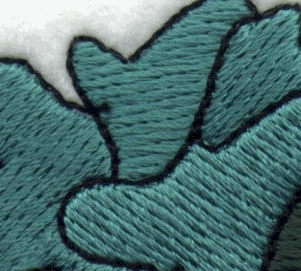Glossary F-G
Facing: Material placed on top of the goods to be embroidered, generally used to support the embroidery stitches. Commonly used on fabrics with a nap such as terry cloth and corduroy. Also used to form a "sandwich" with a backing to stabilize knit fabrics. Can be water soluble or solid material. Also called a Topping.
Fill Stitch: Running stitches laid in rows from edge to edge of the given area to fill. Usualy used to fill in larger areas. Consists of two densities (see Density and Stitch Length), spacing between the rows of stitching and the length of each stitch in the row and the partition lines which are used to place the stitches of each row in relationship to the stitches of the previous row. Also called Ceeding and Tatami stitches. See picture.

Fill Stitch Close Up
Finishing: Part of the embroidery production process including trimming of threads and backings, facing removal, cleaning, steaming, pressing, folding and packaging. Varies by company.
Flagging: Bouncing of goods as the needle moves up and down during the embroidering. Often caused by improper framing, incorrect backing or facing, maladjusted presser foot height or using a hoop too large for the embroidery design. Can cause poor quality embroidery and running problems such as skipping stitches, fraying of thread and breaking of thread.
Format: Type of computer/machine file extension.
Frame: Also called a hoop. Device to hold goods to be embroidered.
Framing Press: Machine to aid in the process of framing. See picture.

P & F Equipment Table Top Framing Press
Frame sash: Part of the pantograph to hold the frames. Also called a sash. Varieties of types of sashes include: border sash, frame sash, tubular sash, cap sash, sock sash and others.
Fusible Backing: Backing that is sealed to the fabric by heat. See Bonding.
Fusing: See Bonding.
Geflect: See Fill Stitch.
Guide Stitch: Running stitches used to assist in placement of an applique or in the placement of a die for cutting of emblems, also called a cut line. See picture.
Guide Stitch
